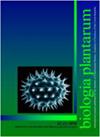Variability of leaf pubescence characteristics in transgenic tobacco lines with partial proline dehydrogenase gene suppression
IF 0.9
4区 生物学
Q4 PLANT SCIENCES
引用次数: 0
Abstract
Proline plays an important role in plant ontogenesis and stress response (Dar et al. 2016, Trovato et al. 2019). The proline content in plant cells increases manifold in response to an increase or decrease in temperature, to drought, soil salinity, nutrient deficiency, increased UV radiation, or exposure to heavy metals resulting in plant osmotic stress (Kuznetsov and Shevyakova 1999). An increase in cell proline leads to the modulation of cell pressure potential, thereby creating an osmotic balance, stabilizes cell membranes, protein and enzyme structures, preventing electrolyte leakage in the cell and oxidative stress. Thus, proline acts as a signalling molecule of stress response in plants (Hayat et al. 2012). Changes in proline content are just one of many plant stress responses: physiological, morphological, and anatomical (Hameed et al. 2010, Ilyas et al. 2020). One of the characteristic morphological changes is associated with leaf pubescence. Leaf pubescence is formed by部分脯氨酸脱氢酶基因抑制转基因烟草叶片短柔毛特性的变异
脯氨酸在植物个体发生和应激反应中发挥着重要作用(Dar等人,2016,Trovato等人,2019)。植物细胞中的脯氨酸含量随着温度的升高或降低、干旱、土壤盐度、营养缺乏、紫外线辐射增加或暴露于重金属而增加,从而导致植物渗透胁迫(Kuznetsov和Shevyakova,1999)。细胞脯氨酸的增加导致细胞压力电位的调节,从而产生渗透平衡,稳定细胞膜、蛋白质和酶结构,防止细胞中的电解质泄漏和氧化应激。因此,脯氨酸在植物中充当应激反应的信号分子(Hayat等人,2012)。脯氨酸含量的变化只是许多植物胁迫反应之一:生理、形态和解剖学(Hameed等人,2010,Ilyas等人,2020)。其中一个特征性的形态变化与叶片的青春期有关。叶片被毛是由
本文章由计算机程序翻译,如有差异,请以英文原文为准。
求助全文
约1分钟内获得全文
求助全文
来源期刊

Biologia Plantarum
生物-植物科学
CiteScore
2.80
自引率
0.00%
发文量
28
审稿时长
3.3 months
期刊介绍:
BIOLOGIA PLANTARUM is an international journal for experimental botany. It publishes original scientific papers and brief communications, reviews on specialized topics, and book reviews in plant physiology, plant biochemistry and biophysics, physiological anatomy, ecophysiology, genetics, molecular biology, cell biology, evolution, and pathophysiology. All papers should contribute substantially to the current level of plant science and combine originality with a potential general interest. The journal focuses on model and crop plants, as well as on under-investigated species.
 求助内容:
求助内容: 应助结果提醒方式:
应助结果提醒方式:


